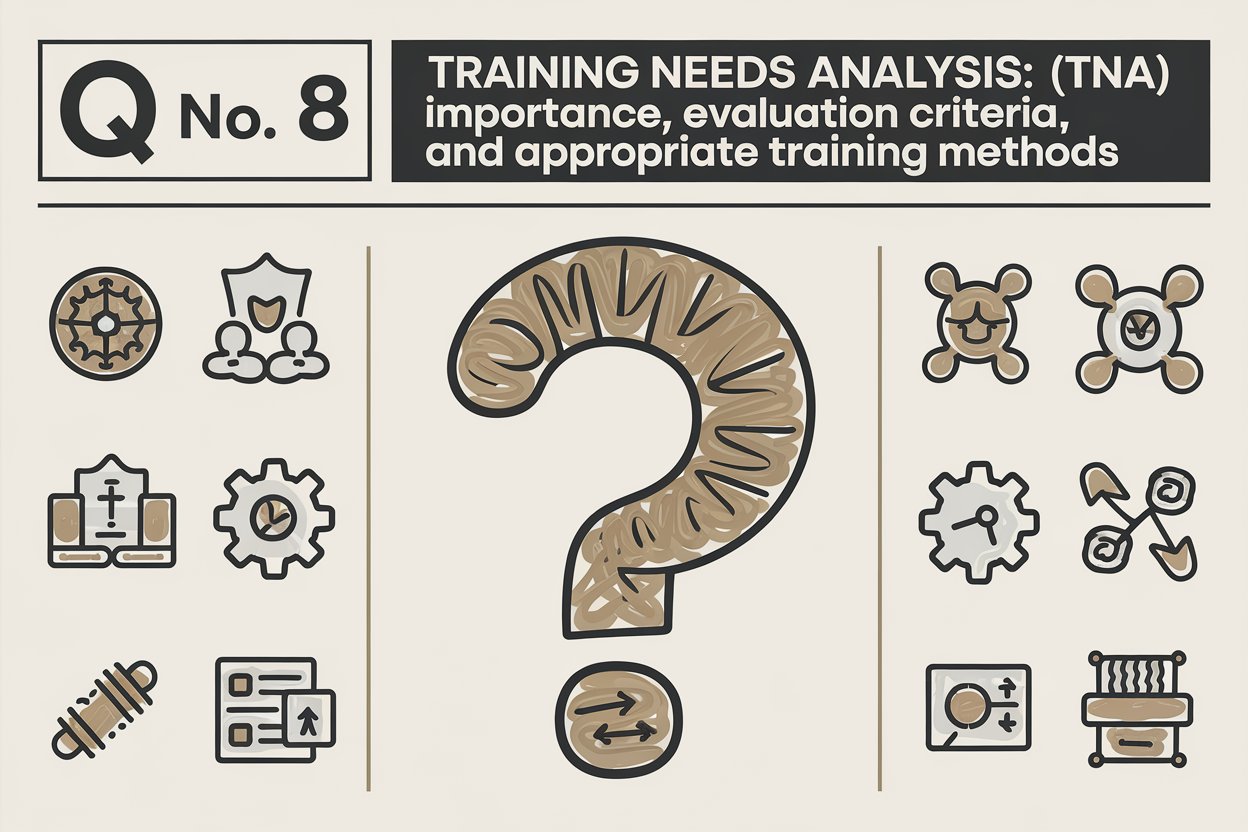Q. No. 8 Training Needs Analysis (TNA): Importance, Evaluation Criteria, and Appropriate Training Methods.

Understanding Training Needs Analysis (TNA): Importance, Evaluation Criteria, and Training Methods
Training Needs Analysis (TNA) is a systematic process used to identify the training requirements of an organization, its employees, or specific job roles. It helps organizations align their training initiatives with business objectives, ensuring that employees acquire the necessary skills and knowledge to perform effectively.
Importance of Conducting TNA
- Identifies Skill Gaps: TNA helps pinpoint the specific skills and knowledge gaps among employees, ensuring that training is targeted and relevant.
- Aligns Training with Business Goals: By linking training needs to organizational objectives, TNA ensures that resources are allocated to areas that will drive performance and enhance productivity.
- Enhances Employee Performance: By addressing training needs, organizations can improve employee competencies, leading to better job performance and increased job satisfaction.
- Optimizes Training Resources: TNA allows organizations to prioritize training initiatives, ensuring that resources are used efficiently and effectively.
- Facilitates Career Development: It helps in identifying the training necessary for employees to advance in their careers, fostering employee retention and motivation.
- Improves ROI: By investing in relevant training programs, organizations can enhance the return on investment (ROI) by increasing overall productivity and effectiveness.
What TNA Should Evaluate
- Current Skill Levels: Assessing the existing skills and competencies of employees to identify gaps.
- Future Skill Requirements: Evaluating the skills necessary for future organizational needs and market trends.
- Job Roles and Responsibilities: Understanding the specific requirements of each job role to tailor training accordingly.
- Performance Metrics: Analyzing performance data to identify areas where employees may be underperforming due to lack of training.
- Training Delivery Methods: Considering different training delivery methods and which are most effective for the organization’s context.
- Employee Feedback: Gathering input from employees regarding their perceived training needs and preferences.
- Learning Environment: Evaluating the organizational culture and environment to determine the best training approaches.
Types of Training Methods and Their Application
Different training methods are suited for various types of training needs. Here are some common training methods and their appropriate applications:
- On-the-Job Training (OJT):
- Application: Best for practical skills and immediate application in the workplace.
- Example: New employees learning from experienced colleagues while performing their tasks.
- Classroom Training:
- Application: Ideal for theoretical knowledge, foundational concepts, and larger groups.
- Example: Workshops or seminars on company policies, compliance, or technical skills.
- E-Learning and Online Courses:
- Application: Suitable for flexible learning and remote employees; can cover a wide range of topics.
- Example: Online courses for software training, industry certifications, or compliance training.
- Simulations and Role-Playing:
- Application: Effective for training in customer service, sales techniques, or emergency response scenarios.
- Example: Role-playing customer interactions to improve communication skills.
- Mentorship and Coaching:
- Application: Best for personal and professional development, tailored guidance, and leadership training.
- Example: Senior employees mentoring juniors to enhance their skills and career growth.
- Workshops and Group Activities:
- Application: Useful for team-building, collaborative skills, and hands-on practice.
- Example: Workshops focused on problem-solving, communication, or project management.
- Blended Learning:
- Application: Combines multiple training methods to enhance learning and retention.
- Example: A mix of e-learning modules followed by in-person workshops to reinforce skills.
Conclusion
Conducting a Training Needs Analysis (TNA) is vital for organizations to identify and address skill gaps, align training with business objectives, and enhance employee performance. By evaluating current competencies, future requirements, and job-specific needs, TNA enables organizations to implement effective training strategies. Utilizing a variety of training methods allows organizations to cater to different learning preferences and contexts, ultimately contributing to a more skilled and effective workforce.
Conducting a Training Needs Analysis (TNA) is vital for organizations to identify and address skill gaps, align training with business objectives, and enhance employee performance. By evaluating current competencies, future requirements, and job-specific needs, TNA enables organizations to implement effective training strategies.Utilizing a variety of training methods allows organizations to cater to different learning preferences and contexts, ultimately contributing to a more skilled and effective workforce.